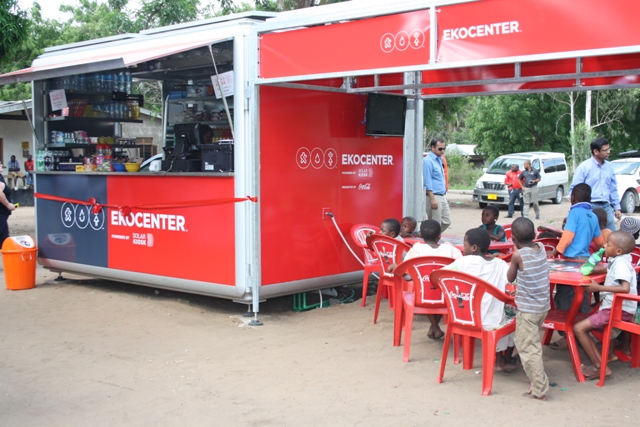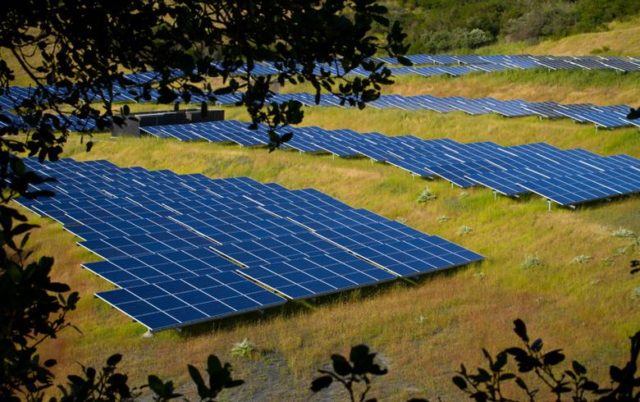>> Microgrids

– Pennsylvania County Considers Installing a Microgrid
The Berks County Industrial Development Authority will evaluate the feasibility of deploying a microgrid at its proposed 155-acre business park. The park would be located at Reading Regional Airport, according to a news report.
The Metropolitan Edison Company Sustainable Energy Fund awarded the agency $25,000 to conduct the microgrid feasibility study. The proposed microgrid would draw on electricity produced by solar PV and combined heat and power (CHP), as well as energy storage capacity.
A growing number of local industrial companies have expressed interest. Two local battery storage manufacturers – East Penn Manufacturing and EnerSys – have joined the consortium of industrial companies supporting the project.
> International
– Solar Kiosks, Mini Grids Spur Electricity Access Gains in Rwanda
Rwandans are responding enthusiastically to installation of solar kiosks and minigrids, according to a news report.
To date, solar kiosks have been installed in off-grid rural areas, bringing affordable electricity to residents and local business owners for the first time. This ability highlights just one of the advantages of solar PV as compared to conventional generation sources.
Solar kiosks are highly reliable, as well as quick and relatively easy to install. They’re also emissions-free and have the potential to reduce deforestation and reduce the pollution and other forms of environmental degradation associated with fossil fuel exploration, development, and power generation.
Furthermore, the solar kiosks are serving as magnets for community members while opening economic opportunities and adding to local jobs and incomes.
A Berlin company manufactures and ships the solar kiosks to Rwanda, where they are known as Ekocenters. Fifteen are up and running to date. Most have capacities of 2 kW and include enough battery energy storage capacity for two weeks of full operation.
In addition to electricity for lighting, refrigeration, and mobile phone recharging, the Ekocenters offer a variety of off-grid solar devices, products, and services.
Less than one-quarter of Rwandan rural households are connected to power grids. The Berlin-based manufacturer expects 32 more Ekocenters will be installed in rural communities this year.
>> Policy, Markets & Investment

*Credit Michael Mees Photography
– Renewables Power Portugal for Four Days
Renewable energy resources – primarily solar, wind, and hydroelectric power – met all of Portugal’s electricity needs for four days – from 6:45 AM Saturday, May 7 until 5:45 PM the following Wednesday, according to a news report.
A week earlier, Germany’s government reported that renewable energy resources alone produced more electricity than consumers needed on one particularly windy and sunny day.
Natural gas-fired power plants automatically shut down during the spike, but coal-fired and nuclear power plants couldn’t ramp down fast enough. German consumers were essentially paid to consume the surplus grid electricity.
– Reports Celebrate Renewables’ Cost Declines, Triple Growth Projections
A series of research reports sponsored by the US Department of Energy (DOE) highlights the benefits of fast-growing solar power capacity and development of technology that speeds and better manages solar grid integration.
The average cost of solar energy has declined more than 65% in only 5 years. Separately, the North American Electric Reliability Corp., (NERC) tripled projections of the amount of grid-connected US wind and solar power it expects will come online over the next 14 years. It also toned down its views regarding renewables’ impacts on electricity grids, the Union of Concerned Scientists (UCS) reported May 19.
UCS blog post authors note that the DOE-led public-private SunShot Initiative partnership is well on its way to achieving the program’s goals of solar supplying 14% of U.S. electricity demand in 2030 and 27% by 2050.
In eight new research reports sponsored by the DOE, researchers describe SunShot’s progress to date, as well as the challenges that remain. Given ongoing declines in cost, forecasters expect that more than 300,000 MW of solar generation capacity will be online in the US in 2030 and 700,000 MW in 2050.
Enactment of President Barack Obama and the EPA’s Clean Power Plan is the primary reason NERC tripled its forecast of installed wind and solar power capacity. NERC estimates 120,000 MW of wind and solar generation will be deployed from 2016-2030, up from 35,000 MW in its previous report, UCS points out.
– Rise of Solar Bank Loans, Online Sales Signal Shift in Market Dynamics
Motley Fool stock advising sees a significant event brewing in US solar market dynamics, one that may work to the detriment of today’s leading third-party solar installation companies.
Financing residential solar installations is becoming easier and less costly amid growing bank lending and the emergence of online sales channels. These changes may well portend a shift in market conditions and dynamics that favor more local sales and installations and eliminates the advantages leading solar finance and installation companies such as SolarCity, Sunrun and Vivint Solar, according to Motely Fool’s report.
These leaders had a distinct competitive advantage that has relied primarily on their ability to mass-market residential solar installations by assuming the burdens of obtaining financing, qualifying for incentives, and providing administration. In addition, these players have been able to tap into Wall Street investment banks and wholesale bond markets to securitize the solar home leases they originate, akin to what mortgage banks and S&Ls do with residential mortgages.
The difficulties of obtaining financing and taking care of the other ¨soft¨ costs are coming down and becoming easier to navigate for individuals, however, according to Motley Fool. Banks are offering home solar loans, and some solar finance and installation companies – including market leader SunPower – are now turning to online platforms to identify, market, and sell residential solar PV systems directly.
Taken together, these nascent trends are negating the advantages SolarCity, Vivint and Sunrun have enjoyed. Motley Fool points to a sharp slowdown in sales and revenue growth and falling margins as evidence of this change.
The solar finance and installation market may evolve into one that’s akin to the residential construction market, where banks provide the financing, and independent local companies take care of most of sales installations.
– Microsoft Raises Renewable Energy Target
Microsoft president and chief legal officer Brad Smith announced the company is raising the bar and making use of more renewable energy to directly power its growing fleet of data centers. In a blog post, company president and chief legal officer Rob Smith announced Microsoft expects renewables will supply 50% of its data center energy needs by 2018 and greater percentages thereafter.
About 44% of the electricity used in Microsoft’s data centers comes from renewable energy sources today, Smith says. “Our goal is to pass the 50 percent milestone by the end of 2018, top 60 percent early in the next decade, and then to keep improving from there.”
Microsoft’s data centers are already 100% carbon neutral, no mean feat. But that success includes purchases of Renewable Energy Certificates (RECs) that offset its own carbon emissions by renewable power delivered and used elsewhere.
“Across the tech sector, we need to recognize that data centers will rank by the middle of the next decade among the largest users of electrical power on the planet,” says Smith.
>> Climate Change

– Temperatures in India Soar; Exceed 50 Degrees Celsius
Temperatures in one Indian city reached a record-high 51 degrees Celsius (123.8 degrees Fahrenheit) this past week.
May and June are typically the hottest months across the Indian subcontinent, a news report notes, but temperatures have soared higher than they did 60 years ago, when the previous record high was set.
The India Meteorological Department (IMD) issued severe heat wave warnings for large parts of northern and western India, including New Delhi, India’s capital.
Demand for electricity in Delhi (population 25 million) soared as temperatures rose as high as 47 degrees Celsius and residents turned on their air conditioners. Hospitals have reported spikes in people being treated for heat stroke. Many states have ordered schools to close and start their summer breaks early.
